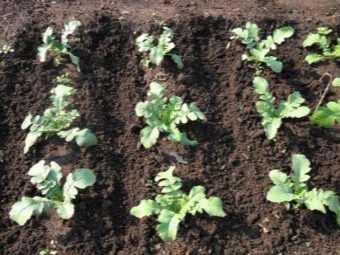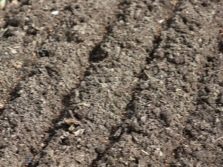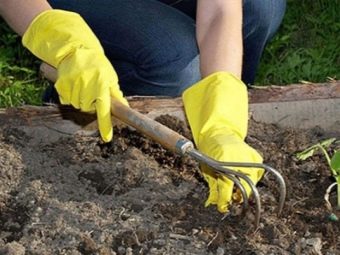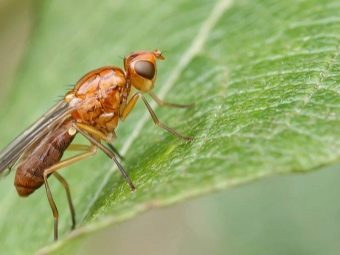When to plant and how to grow black radish in the open field?
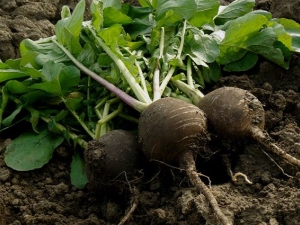
Among the root crops, which are often grown by domestic growers and gardeners, it is worth mentioning black radish.It is famous for its unique taste and balanced composition. And the unpretentiousness of the culture in the care makes it possible to cultivate it, even in regions with harsh climatic conditions.
Culture description
Planting radish and its use were engaged in antiquity. In food, it is actively taken due to the tart taste, resulting from the high content of essential oils. However, the vegetable is cultivated not only for use in cooking, but also for therapeutic purposes, for example, in the fight against colds, as well as for the normalization of the digestive processes in the body.
In the offseason, and in the winter, black radish acts as a natural vitamin complex. In addition, the root is used to treat joints, strengthen hair.
The crop is planted in open ground, and rather simple agrotechnical measures make it possible to get good yields of radish, even for vegetable growers who have minimal experience in growing plants. Black radish is an unpretentious vegetable crop, it is well adapted to different climatic conditions, so that it is planted everywhere in the gardens of the southern regions of Russia, as well as in Siberia, in the Urals and in the Moscow region.
Belongs to the root of the two-year grassy plants of the cabbage family. It is known that sowing and growing this vegetable in Ancient Russia began in the XII century.
Black radish is distinguished by the color of its skin, the sharp and bitter taste of the fruit.
The mass of ripe vegetables ranges from 200 to 600 grams. It grows round. The development of the root occurs in the first phase of the life cycle of the plant - 3-4 months after sowing the seeds. As for the color of the pulp - in radish it is white and rather dense.
The crop is green, pinnately separate. In the second year of life, a seed is formed in the plant. As a rule, dark seeds have a rounded shape.
In addition to unpretentiousness in the care, the vegetable endures frosts withstand (at the same time gives a good harvest). Black varieties are distinguished from different varieties, which are classified according to planting dates - early, medium and late. The first type gives fruit on the 40th day after germination, the second - on the 50-60 day, the harvest of late varieties is carried out approximately 100 days after the emergence of sprouts. Winter radish has a large amount of vitamin C in its composition, due to which the root vegetable after harvesting can be stored without loss of its taste all winter. It is preferable to plant radish seeds immediately on the garden bed.
Timing
The main feature of the cultivation of black radish is the need for a short light day, because when the plant is exposed to light for a long time, the arrow begins to grow, and this adversely affects the taste of the fruit - it will be very hard, so it will not be eaten. Similar specificity of vegetable culture caused observance of certain terms of sowing. Usually this time falls on early spring or the end of summer, when the length of daylight hours will be short.
In addition, the timing of sowing seeds can be tied to preferences regarding storage of the root. Based on this, the grade and the period of work are selected. It is necessary to highlight the possible options and varieties of planting black radish.
- Early vegetable varietieswhich are distinguished by their small size. The term of their aging is about 40 days. Taste of this fruit will have an average sharpness, but no less tangible benefits to the body. Such plants should be planted in March. They are resistant to frost, due to which they are able to give the first shoots at a temperature of about + 3C. But the harvest of early varieties of black radish must be used in food during the first months after harvesting from the bed.
- Summer varieties have a growing season of about 55 days.The timing of sowing is based on the climatic conditions of the region in which the root crop will be grown (usually, works fall in April or early May).
- Winter varieties require sowing in July or August. This radish is distinguished by excellent keeping quality. As for the northern regions, the seeds are planted in the ground around July. The vegetation period of winter radish is at least 100 days.
Some vegetable growers are of the opinion that the time for planting should be selected taking into account the influence of the moon on the plant, so the sowing is carried out in the phase of its growth, which positively affects the taste of the vegetable, as well as the content of vitamins and its keeping quality.
Despite the fairly simple agricultural practices, errors associated with the timing of sowing black radish seeds, can lead to poor yields and low taste of the fruit.
Sowing
For the cultivation of radish, a moistened soil with good access to sunlight will be optimal. It is better to give preference to weakly alkaline soil having a layer of humus. Carrot, cabbage or horseradish will be ideal precursors to vegetables. Radish grows well after legumes and pumpkin. Nearby you can plant potatoes, cucumbers or onions.
Before planting, they dig up the earth, simultaneously fertilizing it with mineral compounds. If the beds are not distinguished by a special nutritional value of the soil, you can use compost or humus. But from the use of manure should be abandoned, because it will spoil the shape and taste of the root. Planting seeds in open ground. Seedlings are rarely practiced, as there is a high probability of mechanical damage to the root system when transplanting young plants, which will make the radish unsuitable for food.
To grow a good vegetable crop, it is necessary to conduct a series of preparatory activities with seeds. They suggest sorting planting material - only large seeds are selected for planting. Before planting, they are germinated in wet rags for 2 days. In addition, the material is soaked for a day in a weakly concentrated solution of potassium permanganate.
If it is not possible to prepare the seed yourself, you can simply purchase already calibrated and germinated products in a store or on the market.
Sowing seeds in the garden is carried out according to the following scheme:
- first of all, the formation of furrows is carried out (their width should be about 2 cm, in increments of 35 cm);
- in the formed furrows deepen seed material with an interval of 10 cm for early varieties, about 15 cm for summer varieties;
- Sowing can be done one at a time or several pieces, the optimal flow rate is 0.4 grams of seeds per 1 square meter. m. beds;
- then the beds are covered with soil, watered and covered with ash to protect plants from insect pests.
With good weather conditions and favorable soil, the first shoots will appear by the end of the first week after planting the seeds in the soil. Too heap beds are best thinned out, leaving only strong shoots of the crop on the plot.
Care
Agrotechnical measures include the following works:
- observance of temperature;
- watering;
- thinning of beds;
- the introduction of fertilizers;
- harvesting.
For the full development of black radish, the air temperature should be at + 20C. But even young cultures are able to endure frosts up to -5С.
Properly organized watering of the plant will guarantee a good harvest of radish at the end of the season. In order for the fruits to be saturated with juice, they will need an impressive amount of liquid, which is why, on average, per 1 square meter. m beds will need about 10 liters. water for one watering. As for the frequency of irrigation, the early plants need to be watered once a week, and those fruits that are planned to be stored in winter, for the entire growth phase, are watered no more than 4 times.
It is necessary to ensure that the soil in the area where it grows black radish, was always wet.Strong fluctuations in one direction or another can cause cracking of the root crop or can provoke roughness of the pulp, the appearance of bitterness in the taste.
The optimal method of irrigation will be the arrangement of drip irrigation beds.
Work related to the thinning of the beds will be needed soon after the formation of the first green on young plants. Between cultures there should be a distance of about 5 cm. The next loosening and thinning should be carried out at the time when the root crop of a radish becomes about 1 cm in size.
It is necessary to ensure that cultures do not interfere with each other to fully develop. The shade from one plant can cause a strong growth of green mass in another. In addition, on overfilled beds, plantings may start to hurt.
Fertilizer is necessary for the culture for the full formation of the root. Mandatory are two dressing radish in a season, but if necessary, their number can be increased. It is worth considering that in the form of solutions / tinctures, top dressing can be introduced into any soil, and only the wet soil on the site is fertilized with dry complexes.
The first feeding is carried out in the period when the first 3 leaves are formed on the plant. To prepare the nutrient solution you will need:
- 60 g of superphosphate;
- 16 g of potassium;
- 20 g. Urea;
- All of these components dissolve in 10 liters. water.
The second fertilizer is made with the same compound after 30 days. If it is not possible to prepare a nutritional supplement yourself, you can purchase at least effective complexes - Darina-6 or Agricola-4. In some cases, organic dressings are used. For this suitable humus or compost.
Harvest time depends on the variety of black radish planted. Summer culture is removed from the site from June until the end of July. The main condition is the size of the fruit, which should be not less than 4 cm in diameter. You should not delay it with harvesting, since the “over-sitting” radish in the ground will lose its elasticity. After collecting the fruits, they must be sorted, and be sure to remove the tops.
It is best to store early radish in containers or packages in a cool place. If dimensions allow, the crop is sent to the fridge. At room temperature, the vegetable can be kept fresh for no more than a week.
But late radish can be collected from the beds in the last turn, but only before the first frosts come. Otherwise, negative temperatures (even at the minimum value) will damage the entire crop in the plot. Frozen product cannot be stored as it will quickly rot.
Usually the collection is held in October. For subsequent storage, only smooth vegetables, not having any damage and signs of rotting pulp, will fit. The best capacity for the collected radish will be wooden boxes filled with sand. The harvest room should be cold and dark.
It is best to store radish in the cellar or basement.
Diseases and pests
The main threat to the crop of root vegetables are black midges and carrot fly. Because of their attack, the green mass and the skin of a vegetable suffer. Such interference with the integrity of the fetus provokes penetration into the flesh of the root crop of pathogenic bacteria, which lead to loss of yield.
Most often insects are attacking young cultures. To protect the plants, it is necessary to maintain the soil moisture. In addition, an effective way to protect the radish from pests will be the addition of sand to the soil, as well as sprinkling it with wood ash.
To insects that are dangerous to the vegetable, can also be attributed slugs, rapeseed flower beetle and cabbage leaf beetle.
For preventive treatments, you can use some proven natural remedies:
- spraying soap;
- processing plants infusions of herbs (in this case, you should use celandine or wormwood);
- lime, pepper and wood ash based formulations;
- treating a moist plant with tobacco dust or dried tansy;
- composition based on vinegar;
- from slugs, the edges of the beds are sprinkled with eggshell.
In addition to proven folk remedies, specialized drugs are available for the sale of pests:
- "Lipocide";
- "Fitoverm";
- "Intravir" and others.
Good results on reducing the risk of crop damage by pests, give a joint planting of black radish with onions or garlic.
As for diseases, the culture is prone to defeat mosaic and powdery mildew. The main reason for the development of diseases is the wrong agricultural technology. In the fight against radish diseases, the use of copper-containing compounds gives good results.
How to grow black radish, see the following video.



